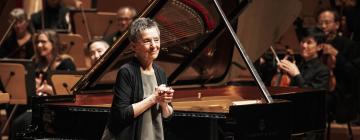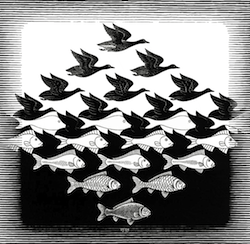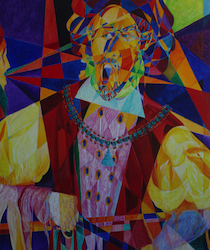
San Francisco Opera fans of a certain vintage will all remember Vorpal Gallery on Grove, just a block away from the War Memorial. Mention the gallery and the response from oldtimers is likely to be: "Escher!"
Opera-only purists had frequented the gallery's second-floor performance space — pesky wooden columns in the middle of the hall playing havoc with the view — where recitals and Merola Program events took place.
A much larger faction, whose interests are broader, stopped by the Vorpal to see an ever-changing display of classical and modern art, and — especially — the world's most extensive motherlode of M.C. Escher's work.
Before more about that, let's time-travel three decades to the present, and see what's going on in Burlingame's new Peninsula Museum of Art. Focus on a small, vibrant exhibit of paintings currently on exhibit.
Opera again, complex, engrossing images of Anne Boleyn and Henry VIII from Donizetti's Anna Bolena — oil paintings on Belgian linen — along with whimsical characters such as Startled Fool and Dying Minstrel, abstract landscapes, and others — fascinating by themselves, but even more meaningful if you know who the artist is.
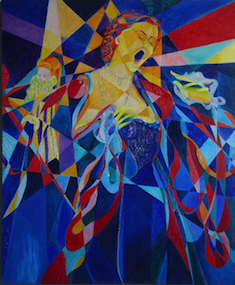
It's Muldoon Elder, a major figure on the Bay Area arts scene, and — to get back to the beginning — owner/operator of the Vorpal from 1962 until he closed it 42 years later "to have more time and energy to paint and write."
Elder, 78, who says this exhibit "means to explore the intricate language and movement of color and light," was also art editor of the avant-garde literary magazine Genesis West, and in 1974, he opened the New York City branch of the Vorpal. Artists he represented included two of the great print masters of the 20th century, Yozo Hamaguchi and Escher.
Elder's championing of Escher, the unique Dutch graphic artist of mathematically inspired woodcuts and lithographs, included a major portfolio, first-time exhibits, and representation of the artist.
When the first comprehensive retrospective of Escher's dazzling works opened in the Vorpal in 1972, the line of 3,000 outside stretched five blocks long, and Joan Baez serenaded the crowd on the street waiting for admission.
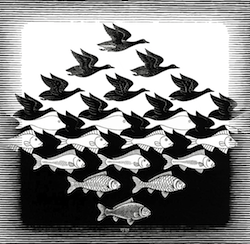
On the way to visit Escher in Amsterdam, Elder learned that the artist was near death. Invited to come, Elder said he didn't want to interrupt the family gathering, but — as Elder recalls — one of Escher's three sons told him: "You must come over right now, you're the one who made father famous!"
Among Elder's accomplishments was his support for new and unusual artists. The Vorpal, for example, was one of the few venues exhibiting works by the controversial San Francisco painter Bernice Bing's works as early as 1962.
Of his eventful and varied career, Elder says: "There are many ways of looking at life and I have tried to avoid wearing the blinders that only allow a single path and if a painting is successful, it will be like a great poem, you can always return to it and it will never wear out."
Paintings at the Peninsula exhibit are for sale, but they do cost a pretty penny, ranging from $30,000 to $3 million each in the The Dying Minstrel series; the two opera paintings are available as a pair only, for $1,200,000 total.
